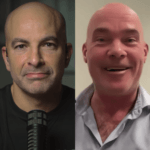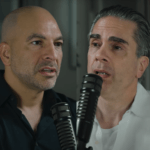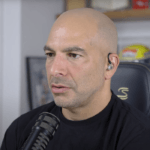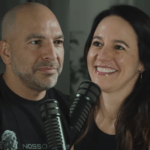In this “Ask Me Anything” (AMA) episode, Peter answers questions related to the leading cause of death in both men and women—atherosclerotic cardiovascular disease (ASCVD). He highlights the most important risk factors for ASCVD, such as apoB, LDL, hyperinsulinemia, and Lp(a), and explains the mechanism by which they confer risk and how these factors are interrelated. Peter also dives deep into the data around apoB to try to answer the question of how much residual risk is conferred for ASCVD through metabolic dysfunction once you correct for apoB. He also looks at the data around lifetime risk reduction of ASCVD in the context of low apoB.
If you’re not a subscriber and listening on a podcast player, you’ll only be able to hear a preview of the AMA. If you’re a subscriber, you can now listen to this full episode on your private RSS feed or our website at the AMA #43 show notes page. If you are not a subscriber, you can learn more about the subscriber benefits here.
We discuss:
- A racecar analogy for understanding atherosclerotic cardiovascular disease [2:00];
- Defining and differentiating apoB and LDL-C [10:00];
- The interrelated nature of insulin levels, apoB, triglycerides, and ASCVD parameters [13:00];
- Another way that hyperinsulinemia plays a role in endothelial dysfunction [18:00];
- Why Peter uses the oral glucose tolerance test (OGTT) with all patients [20:15];
- Is there any evidence that hyperinsulinemia is an independent contributor to ASCVD? [23:00];
- Thinking through risk in the context of high-fat diets resulting in improved metabolic metrics but with an elevation of apoB/LDL-C [27:30];
- Thinking through risk in the context of low apoB but higher than normal triglyceride levels [32:15];
- The importance of lowering apoB for reducing ASCVD risk [38:15];
- Data on men and women with familial hypercholesterolemia that demonstrates the direct impact of high apoB and LDL-C on ASCVD risk [47:45];
- Importance of starting prevention early, calcium scores, and explaining causality [52:30];
- Defining Lp(a), its impact on ASCVD risk, and what you should know if you have high Lp(a) [56:30];
- Lp(a) and ethnic differences in risk [1:00:30];
- Why someone with elevated Lp(a) should consider being more aggressive with apoB lowering strategies [1:05:00];
- Addressing the common feeling of hesitancy to taking a pharmacologic approach to lower ASCVD risk [1:07:15];
- Peter’s take on the 2022 Formula 1 season and thoughts on 2023 [1:15:15]; and
- More.
A racecar analogy for understanding atherosclerotic cardiovascular disease [2:00]
Previous episodes on this topic:
- AMA 34
- Episode #210 with Benoît Arsenault on Lp(a)
- #185 with Allan Sniderman
- #140 with Gerald Shulman insulin resistance
***
What’s more or less known:
- apoB can increase risk
- Lp(a) can increase risk
- Insulin, not good for ASCVD
But the open questions include things like:
- How can these risk factors collectively influence the risk of someone?
- And how to think through hypotheticals such as:
- What if my apoB is low, but my Lp(a) is high?
- What if my insulin is good, but my LDL or apoB is raised?
Racecar analogy:
- Imagine your lifespan is the length of time it takes you to drive a race car from point A to point B, where point B is driving it off a cliff
- You have two pedals: the accelerator and the brake pedal
- Your feet are always on both pedals, so it’s really just a question of how hard are you pressing on each one
- In this analogy, there’s never a point when the car is not moving towards the edge of the cliff, but you can do things that really speed up the drive, which means you’re moving towards death more quickly
- That would mean you’re pressing much more on the throttle than you are on the brake
- Conversely, you could have minimal pressure on the throttle and much more pressure on the brake and really slow your forward progress.
- Then the questions become:
- What are the factors that you could be doing that accelerate the drive towards the cliff?
- What are the things that you can be doing that slow that trajectory?
- That said, some things aren’t under you control like Lp(a)
- Lp(a) is just a low level of maintenance throttle that is put on the pedal
- So somebody who’s born with a low Lp(a) has a very low throttle application
- Someone who’s born with a high Lp(a) would have a higher throttle application.
- we would just call this baseline maintenance throttle.
- High apoB is also an accelerator, but you can apply the “brake” by lowering it
- You can lower apoB with dietary changes (slight push on brake)
- Or you can lower it with the application of pharmacotherapy (hard push on brake)
- The more you’re lowering apoB, the harder you’re pushing on the brake
- If a person has, for example, type 2 diabetes that is generally accompanied by hyperinsulinemia
- what is hyperinsulinemia doing in this equation? It is pressing harder on the throttle
- It is accelerating through mechanisms like upregulation of APOC3 expression, which regulates apoB in the wrong direction
- So more APOC3 means more apoB impacts the LDL receptor, the LDL receptor related protein. It moves all of these things in the wrong direction
- Other examples of accelerators:
- Smoking
- High blood pressure
- So what are the big three things that are driving ASCVD?
- Smoking,
- hypertension,
- apoB.
- Then, of course, you have other things, like Lp(a), hyperinsulinemia
“That would be my analogy, which is we have a car that we can’t actually stop, but we can really slow it down to a dull roar. That’s going to be through some combination of manipulating the brake and the throttle.” —Peter Attia
One thing to add to this analogy:
- If you’re 100 feet from the end of the cliff (i.e., you’re an older person) and you’re traveling fast, you better get ready to lock up the brakes.
- If you have a mile between you and the cliff, you can be a lot more judicious in your use of the brake pedal
⇒ AMA #34 stresses the importance of starting preventative strategies early in life
Defining and differentiating apoB and LDL-C [10:00]
ApoB and LDL-C
- oftentimes these are in concordance, sometimes they’re in discordance
- Peter always prefer to know apoB
- Oftentimes, people don’t know their apoB and they only have their LDL-C, which can be a predictor as well
{end of show notes preview}






I wish they would have commented on all-cause mortality with regard to lower LDL-c/ApoB levels. While the effects on ASCVD are clear, all-cause mortality seems less clear with some studies showing a U-shaped curve. If your Formula 1 car is heading toward a cliff, you want to slow it, not swerve toward a different cliff. For example, https://www.researchsquare.com/article/rs-1039792/v1
Haven’t looked into the study you referenced, but have you considered the idea, that perhaps the patients registered with ASVCD got help through medication etc. thus preventing or at least postponing them from dying? 😉
How do I know what percentile I am in as far as ApoB? This is not given on my results, just a number, with a reference range. My number was 70. So what percentile is that? I am 54/F. Insulin sensitive as per Trig/HDL (0.84). My cholesterol is typically 200, LDL-c 100. Lp(a) 6. Is that what we go by, percentile and not the actual number? This is a great episode, but I can’t figure out what to do with it when I can’t even figure out “where I am” so to speak. I had to do this test on my own. So talking to my primary is a useless endeavor. She would just look at me like I had three heads. I don’t have a cardiologist that I go to. So that’s not helpful either.
If youre white, then 70 is in the 75th percentile (the “worst” 25%) – by figure A, shown around 1:08:00 for awhile. From figure C, your hazard ratio doesn’t vary a whole lot from your risk if you were average (50th percentile). Maybe 20% higher risk (hr=1.2) in relative risk (I don’t know what it is in absolute risk). Maybe Dr. Attia would suggest the apo lowering med but not be adamant about it, but not suggest a statin (just my guess, maybe he will confirm or correct that if he sees your comment).
Tom Day spring shared a reference chart with Apob Values and what percentile
https://twitter.com/Drlipid/status/1554620905673969666
Looks like based on your apob u wi be under 10th percentile
Is this figure that “Peter loves showing three types of data that unambiguously show us this to be true”…does this depict relative or absolute risk reduction? Relative risk reduction can be misleading as 2% to 1% relative reduction is 50% but on an absolute basis you are only improving risk by 1%. I hate when charts are used & don’t make this clear.
I dont recall which figure that comment was made about. He usually does try to make clear relative vs abs. Hazard ratios are always relative, if that helps
Very interesting pod, as I was talking to a 56 y.o GP who is following a carnivore diet, is familiar with Peter’s research, but has a 0 calcium score and has measured her carotid arteries as being clear. She is anti-statins and feels no fear from the carnivore approach and is sceptical of big pharma. So it hit a lot of interesting counterpoints.
While I do understand the distinction between the individual level benefit versus the system level (i.e. health care rationing), I feel Peter and his cohort have a major blind spot. That is there is never any consideration of the effects of individual actions for personal health gain on climate change. So I would look at the carnivore diet and dismiss it on the grounds of its hugely excessive effect in terms of her carbon footprint/climate change with no discernible health benefit according to Layne Norton. Even in terms of the use of sauna, having an individual sauna that one powers up, if done with non-renewable sources again is choosing the individual with no consideration of the collective.
Thanks for this. I didn’t agree with the safe vac comment. What about the Covid Global Summit, a censored and harassed collection of 17,000 doctors and researchers led by mRNA pioneer (arguably inventor, incl the patents) Dr. Robert Malone and by the former pfizer vp of Respiratory, Dr. Yeadon? Let’s try to get some folks over onto rumble and see some *uncensored* stuff. Or many other researchers there, forced to be only on rumble. (If it were so safe there wouldn’t be such aggressive censorship of even simple presentations of actuarial and medical statistics.) Even among the uncensored we have the Dr. Drew interview of NYU’s Dr. Pantazatos, which is on youtube – as is the summarizing work of Dr. John Campbell. Anyway, have a good day.
Another excellent podcast. Thank you to Peter, Nick, and the team. Two questions- can you provide, or cite the reference, for the Abo B percentiles by age that Peter references (as his treatment guidelines). And, Is there any limit that Peter would not try to push Apo B levels down? It sounds like he feels that everyone would benefit from lower levels, an as such, should everyone be on a statin or other Apo B lowering therapy?
Length of the race track:
I’ve heard the rule of thumb that exposure to 8 gram*years/ml of LDL-C results in heart disease and or some related event.
So an LDL-C of 100 mg/ml for 80 years or an LDL-C of 160 mg/ml for 50 years.
Wondering how accurate that 8 g*year/ml that you have seen.
What’s the equivalent track length in units of ApoB?
I find it extremely hard to believe that if everyone were on a statin and PCSK-9 inhibitor with neonatal apo B levels we would have essentially eliminated cardiovascular disease. In the era of personalized medicine this is counter-productive and lends itself to outdated modes of thinking. What problems are we creating by introducing this level of pharmacologic intervention on cholesterol that plays countless roles in our unique physiology? I will continue to listen to your thoughts and those of others, but this is one area I disagree with for now.
Given this information, what significance is the apoB/A ratio?
“The test of a first-rate intelligence is the ability to hold two opposing ideas in mind at the same time and still retain the ability to function.” F. Scott Fitzgerald
This succinct AMA (at least its non-Formula 1 bookends !) tied a bow of confidence on the gift of this week following my yearly physical. Despite stellar low triglycerides, high HDL, lowest percentiles of homocysteine and CRP and no evidence of hyperinsulinemia, my LDL-C and Apo-B have, however, crept beyond safe ranges, and I’ve finally decided – after much internal debate but led ultimately by the knowledge and wisdom gained as an enthusiastic 3 year Drive member – to swallow my pride and employ that tool called a statin. Thanks Peter !
I think you made it clear here and in a previous AMA, why we need to lower our ApoB levels. Now we would love to hear more about the HOW, going deeper into PCSK9 inhibitors and statins or alternatives, exploring side effects, high/low doses and not less importantly: how can I approach my GP to ask him about this?
Fig. 1 appears to be from Ference et al, European Heart Journal (2017), 39, pp 2459-2472. It is Fig. 2 in that paper.
This was updated
Tom Day spring shared a reference chart with Apob Values and what percentile
https://twitter.com/Drlipid/status/1554620905673969666
Looks like based on your apob u wi be under 10th percentile
Ticketmaster:music Eselvier:medicine
T/F?